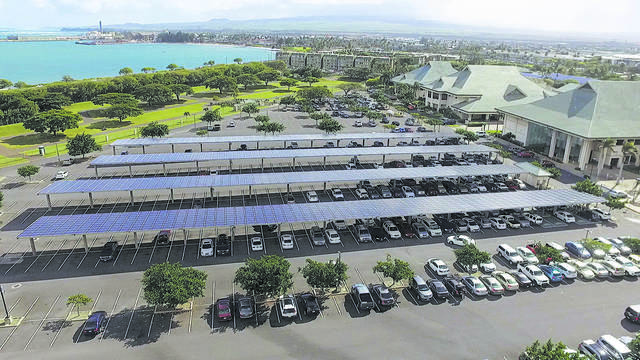Solar panel installer is fastest-growing occupation in Hawaii, report says

COURTESY UNIVERSITY OF HAWAII
Some of the solar panels at University of Hawaii Maui College provide shade for its parking lots. Hawaii is one of eight states where the occupation of solar panel installer is growing the fastest, according to an interactive map of the fastest-growing occupations in every U.S. state released by Time Inc.’s MONEY last week.
Hawaii is one of eight states where the occupation of solar panel installer is growing the fastest, according to an interactive map Opens in a new tab of the fastest-growing occupations in every U.S. state released by Time Inc.’s MONEY last week.
In Hawaii, the solar panel installer jobs are growing at a rate of 16 percent. The job pays a median of $39,490 per year, but higher in some states, including Florida, where the wage is $44,950 a year.
“Solar is a premier job-creating industry in the United States,” said Dan Whitten, vice president of communications for the Solar Energy Industries Association in an e-mail. “Recent trade restrictions imposed by the Trump Administration have been roadblocks for that economic growth, but we are a resilient industry, as evidenced in this MONEY report. Solar installation is the fastest-growing job in 8 states, including Hawaii, which has a strong solar market and vast potential to grow. Utility-imposed interconnection constraints have been a barrier for solar in the state, but the market is growing, and creating jobs along with it.”
Solar panel installer positions are also growing in Minnesota (34 percent), California (29 percent), New Mexico (25 percent), Florida (22 percent), New Jersey (21 percent), North Carolina (14 percent) and Missouri (10 percent).
The number of wind turbine service technician jobs, meanwhile, is growing at rates of 13 to 21 percent in Iowa, Colorado, Nebraska and Texas. Wind turbine service technicians make $61,450 in Colorado.
Other growing occupations include those in the high tech sector, such as software developer in South Dakota, and statistician in Maine. In Oregon, the highest job growth rate is for an animal trainer, at 32 percent, with a salary of $27,130.
Don't miss out on what's happening!
Stay in touch with breaking news, as it happens, conveniently in your email inbox. It's FREE!
MONEY used short-term projects from Projections Managing Partnership to find the fastest-growing occupation in every state, using the percentage of projected change between 2017 and 2019. Occupations with fewer than 100 workers were not considered.



